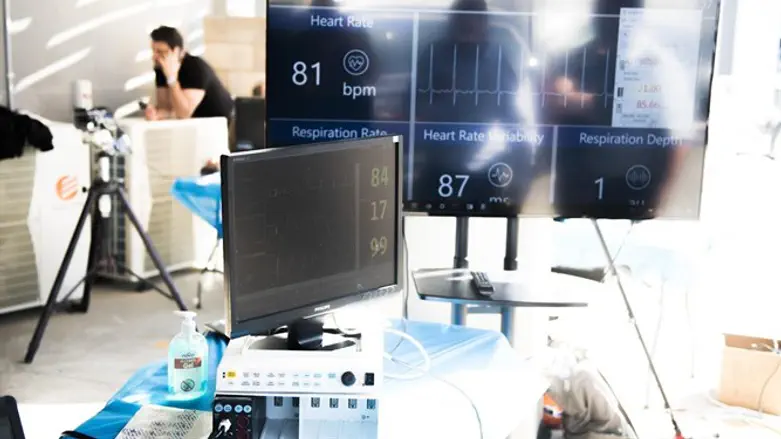
The National Emergency Team of the Directorate of Defense Research and Development (DDR&D), in the Israel Ministry of Defense (IMoD), has adapted two systems developed by defense industries Elbit and IAI, to measure the vital signs of patients.
The data, including pulse, respiratory rate and temperature, are measured remotely using a combination of radar and electro-optical sensors, thus reducing the risk of infection to medical personnel. The next stage of development is screening and prioritizing patient care based on the analysis of vital data.
The National Emergency Team led by the Director of the DDR&D, Brig. Gen. (Res.) Dr. Dani Gold continues to identify and develop advanced technological solutions to help fight the spread of the COVID-19 virus. In recent days, the team has successfully completed a test in which two systems were adapted to measure the vital data of patients, remotely. The systems, developed by Elbit Systems and Elta, a subsidiary of IAI, use an array of radar and electro-optical sensors. The team has two medical advisers, Dr. Yossi Shaya and Dr. Akiva Esterson of the Beilinson - Rabin Medical Center.
The vital signs measured using the system will be displayed on a monitor for the physician to review. In addition, the data is displayed in a graphic user interface that facilitates decision-making processes. The system will enable medical staff to remain in a sterile environment, and limit contact with the patient, thereby significantly reducing the risk of infection.
The goal of the test was to determine the systems’ reliability and accessibility. As a result of the test, plans are underway for the implementation of these systems in medical centers. The test was conducted in collaboration with Elbit, Elta Petah Tikva, EchoCare Technologies, Vayyar, Neteera, Rabin Medical Center (Beilinson and Sharon Hospitals), the Directorate of Research and Development in the DDR&D, led by Brig. Gen. Yaniv Rotem, Dr. Yoni Savir of the Technion, and additional research groups from the academic community and the IDF.
Col. A, DDR&D in the Ministry of Defense said: "The combination of the technological capabilities of the defense industries and the extraordinary capabilities of the officers in the DDR&D, enables us to adapt systems developed for security purposes, to fulfill medical needs in light of the coronavirus. The system that we have adapted is based on radar and thermal cameras and can measure patients’ vital signs remotely. "
Dr. Yossi Shaya, Beilinson Medical Center said: "The DDR&D turned to us with the idea of monitoring patients using radar. These are systems that we don’t normally work with, but they asked us what our needs are, in the hope that these systems may be adapted to fulfill them. They asked what vital signs should be monitored among corona patients, at the point of diagnosis and during treatment – and aimed to do so without the involvement of medical staff. The idea is that our medical teams are at the forefront of this fight and should be protected, and the way to do so is to reduce direct contact with corona patients. Thanks to the creative thinking of the DDR&D, of using technology that is normally used against [Israel’s] enemies, I hope we will be able to win in the fight against the COVID-19 virus."
Yossi Cohen, VP CTO, Elbit Systems added: "We are delighted to take part in the effort to develop new technological solutions that will contribute to the fight against the coronavirus. We will continue to harness groundbreaking technological capabilities developed in the company to assist the efforts of the Ministry of Defense, medical centers and local authorities.
Yoav Tourgeman, IAI VP and Elta CEO: "IAI is proud to be part of the national effort to fight the COVID-19 virus. Elta's advanced radar systems, which are used in routine defense activities, have been adapted to monitor the vital signs of patients and to protect medical staff. We will continue to support the national effort to find effective and innovative solutions, and together we will succeed."
Within the framework of the National Emergency Team to combat the virus, the DDR&D staff and their partners are working to adapt technology developed for military / security needs for civilian applications. The work is done around the clock and in shifts, in order to quickly reach the implementation stage in hospitals. The system for the remote monitoring of vital signs will be added to the comprehensive toolbox that the DDR&D is developing, to quickly diagnose and identify carriers, to prevent the spread of the virus, to prevent the infection of medical staff within hospitals, and to manufacture protective gear for medical staff.
